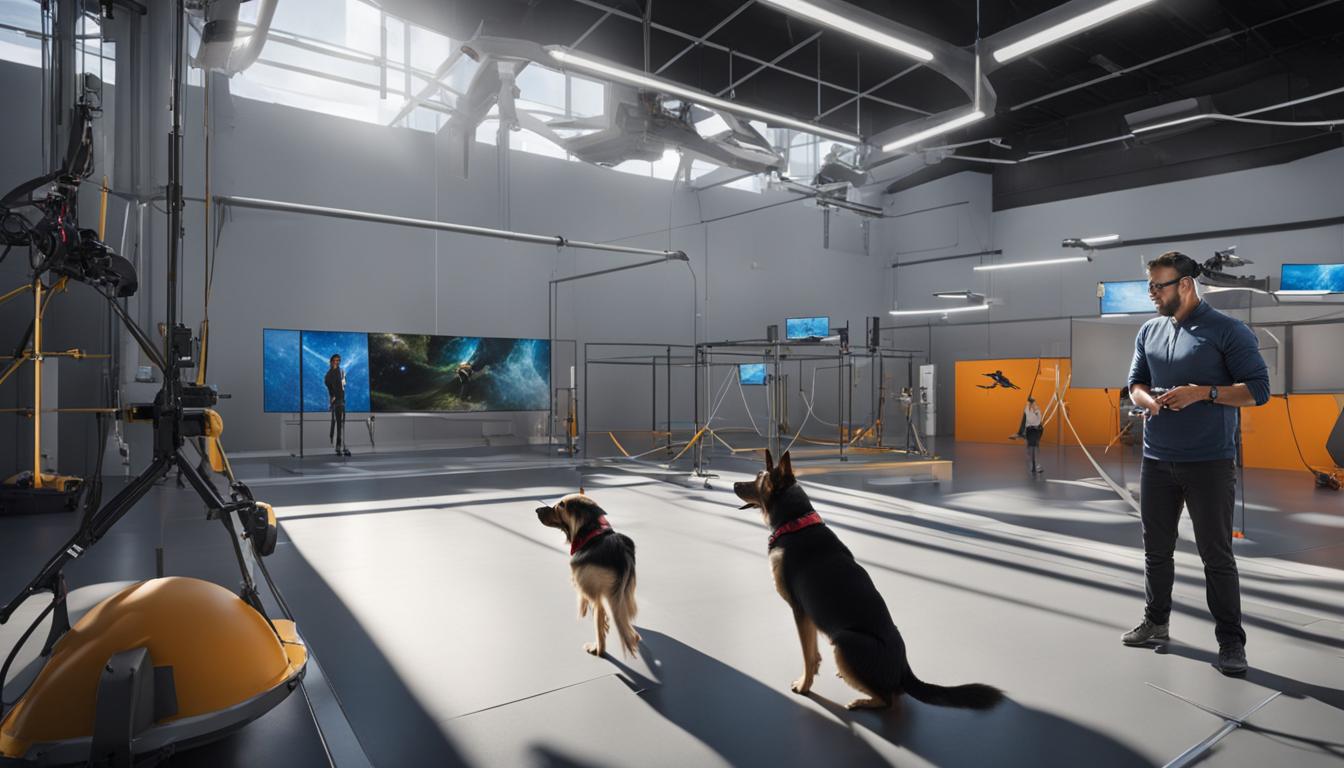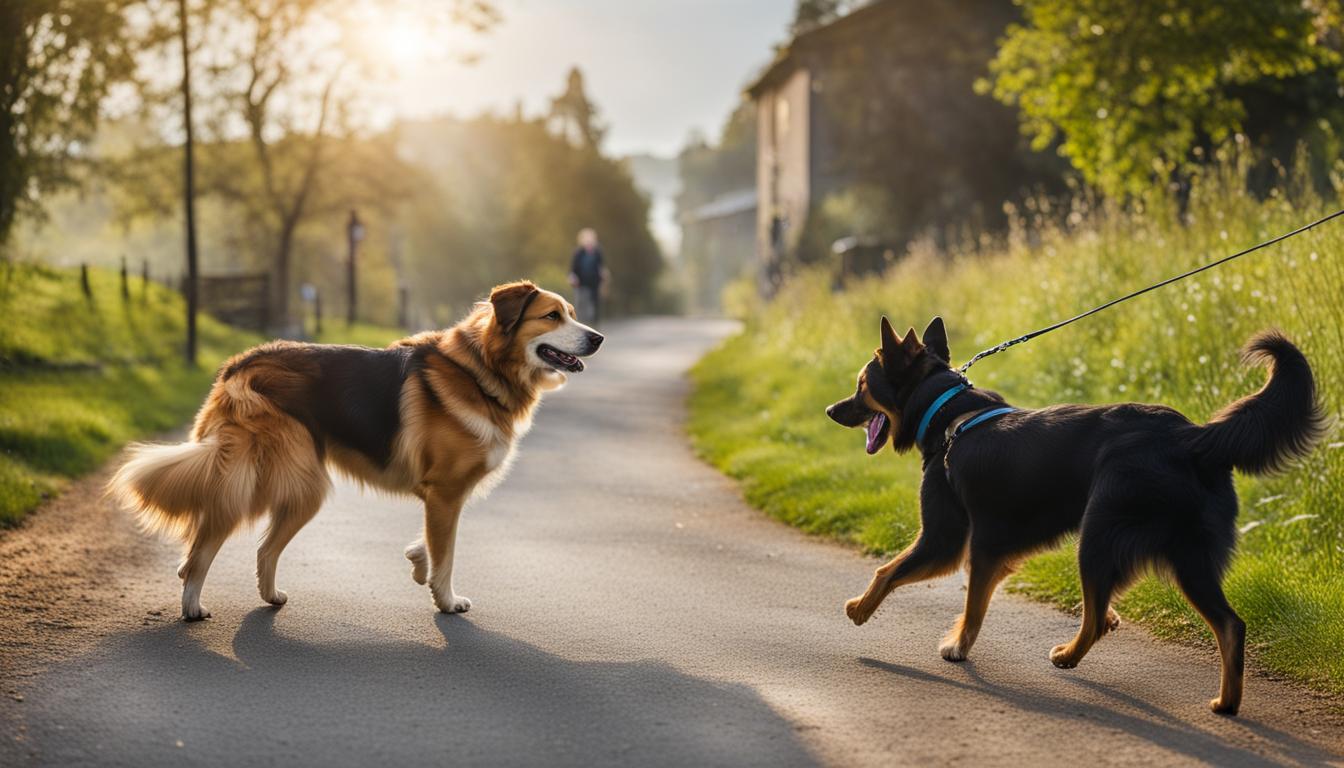Welcome to our guide on managing hyperactivity and overexcitement in dogs! If you have a furry friend who just can’t seem to calm down, don’t worry – we’ve got you covered. From calming techniques to reducing overstimulation, we’ll provide you with expert advice and strategies to help your dog find their inner zen.
Hyperactivity in dogs can stem from various factors, including anxiety and a lack of exercise. To effectively manage this behavior, it’s crucial to tackle the underlying causes and implement strategies that promote calmness. But fret not, we’re here to give you all the tools you need.
So, grab a treat for your pup and get ready to discover new ways to manage their hyperactivity. Let’s dive in!
Key Takeaways:
- Understanding the root causes of hyperactivity in dogs is key to managing their behavior.
- Attention deficits and a lack of early training can contribute to hyperactivity.
- Detox training and regular exercise can help reduce overexcitement in dogs.
- Positive reinforcement and understanding your dog’s body language are effective techniques in managing hyperactivity.
- Seeking professional help from a dog trainer can provide you with the necessary tools to manage canine hyperactivity.
Addressing Attention Deficits: The Key to Calm
Attention deficits can contribute to hyperactivity in dogs, making it important to focus on providing the right amount of mental and physical stimulation. Dogs rely on human interaction and engaging activities to keep their minds and bodies active and balanced.
To effectively address attention deficits, consider incorporating the following techniques into your dog’s routine:
- Set aside dedicated playtime: Regular playtime with your dog helps provide mental and physical stimulation. Engage in activities like fetch, tug-of-war, or hide-and-seek to keep them active and entertained.
- Use interactive toys: Interactive toys, such as treat puzzles or puzzle balls, require dogs to work for their reward. These toys challenge their problem-solving skills and help reduce boredom.
- Try obedience training: Obedience training not only teaches your dog basic commands but also helps improve their focus and attention span. Consistent training sessions can help redirect their energy towards positive behavior.
- Provide mental challenges: Engaging your dog’s mind through activities like scent work, agility courses, or obedience drills helps tire them mentally, reducing hyperactivity.
Quote:
“A well-stimulated dog is a happy dog. By addressing attention deficits and providing the right mental and physical stimulation, you can help your furry friend find balance and calmness.” – Anonymous
Remember, every dog is unique, so it’s important to assess their individual needs and tailor your approach accordingly. By focusing on attention deficits and incorporating these techniques into your dog’s routine, you can help them achieve a calmer and more balanced state.
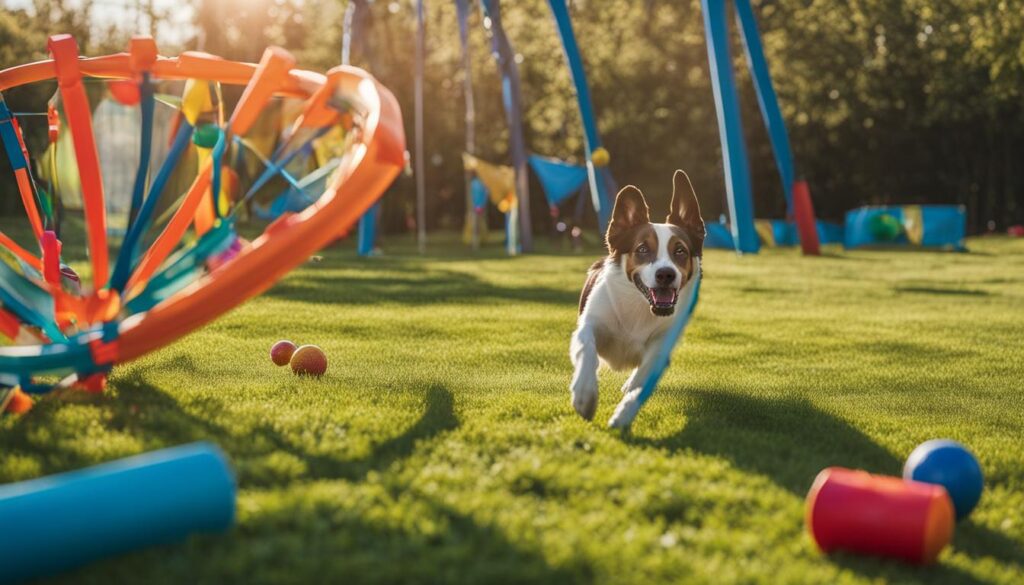
Table: Hyperactivity Management Techniques
| Technique | Description |
|---|---|
| Playtime | Engage in regular play sessions to provide physical and mental exercise. |
| Interactive Toys | Use toys that require your dog to work for rewards, stimulating their mind. |
| Obedience Training | Train your dog to follow commands, improving their focus and attention span. |
| Mental Challenges | Engage your dog in activities that challenge their problem-solving skills. |
Laying the Foundation: Early Training Matters
Dog obedience training is a fundamental aspect of managing hyperactivity in dogs. By providing your furry friend with the right guidance and structure from an early age, you can establish a strong foundation for calm behavior. Dogs are pack animals by nature, and they thrive when they have a purpose and a leader to please. Here are some key points to consider when it comes to early training:
- Behavioral regulation: Obedience training helps dogs learn commands that promote calm behavior and regulate their actions. By teaching your dog basic commands such as “sit,” “stay,” and “leave it,” you can establish a sense of order and control.
- Pack mentality: Dogs have a natural instinct to follow a hierarchy within their pack. By assuming the role of the pack leader through training, you can help your dog understand their place in the family unit and reduce hyperactive behaviors.
- Calming commands: Incorporating specific commands that encourage relaxation can be beneficial in managing hyperactivity. For example, teaching your dog the command “settle” or “relax” can help them learn to calm down and find inner peace.
Consistency is key when it comes to early training. Make sure to use the same commands and techniques consistently to reinforce the desired behaviors. Positive reinforcement, such as treats and praise, can also be highly effective in motivating your dog to learn and obey.
“Early training plays a crucial role in managing hyperactivity in dogs. By providing structure and guidance, you can effectively manage hyperactivity and encourage obedience.” – Dog Trainer
Why Early Training Matters
Early training is essential because it sets the stage for your dog’s future behavior. By investing time and effort into training your dog from a young age, you can prevent and manage hyperactivity. It allows you to establish clear boundaries and expectations, making it easier for your dog to understand what is acceptable behavior.
Additionally, early training promotes mental stimulation and engagement, which can help curb hyperactivity. Dogs need mental challenges to thrive, and training provides them with the opportunity to learn and problem-solve. By keeping their minds occupied, you can reduce their need for excessive physical activity and prevent overexcitement.
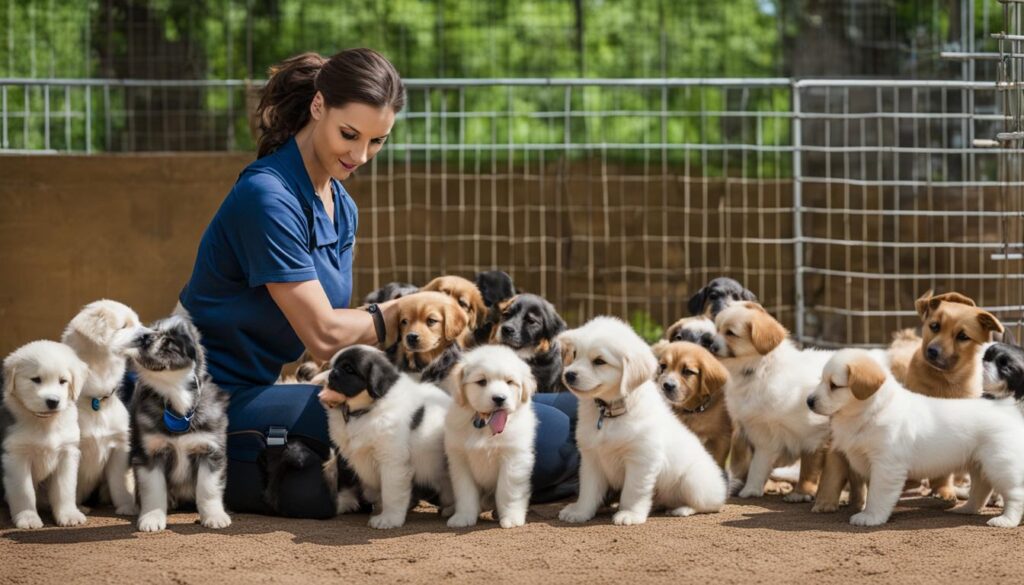
Summary
Early training is a crucial component in managing hyperactivity in dogs. By implementing obedience training techniques, establishing a pack mentality, and incorporating calming commands, you can instill a sense of order and control in your furry companion. Consistency and positive reinforcement are key to achieving long-lasting results. Remember, a well-trained and well-behaved dog is a happy dog!
| Obedience Training Benefits | Hyperactivity Management | Behavioral Regulation |
|---|---|---|
| Establishes a strong bond between you and your dog | Reduces excessive energy and overexcitement | Teaches your dog to follow commands and rules |
| Promotes mental stimulation and engagement | Prevents destructive behaviors caused by boredom | Helps your dog understand boundaries and expectations |
| Improves overall obedience and responsiveness | Enhances focus and attention span | Provides structure and guidance for your dog |
Try Detox Training to Prevent Over Excitement on a Leash
Detox training is a powerful technique that can help your dog maintain calm behavior while on a leash. It is particularly beneficial for dogs that tend to become overly excited and easily stimulated when they encounter other people or animals during walks. By implementing detox training, you can teach your dog to control their impulses and remain composed, even in exciting situations.
The process of detox training involves setting clear boundaries and expectations for your dog while on a leash. During walks, it’s important to discourage playful behavior and instead focus on promoting a calm and controlled state. Avoid allowing your dog to pull, lunge, or jump, as these reactions can fuel their excitement. By consistently reinforcing calm leash behavior and redirecting their attention to you, you can gradually condition your dog to understand that being on a leash means maintaining a calm and composed demeanor.
Consistency is key when it comes to detox training. Establish a routine during walks and use positive reinforcement techniques, such as treats or praise, to reward your dog for good behavior. Keep in mind that it may take time for your dog to fully adjust to the new expectations, so patience and persistence are essential.
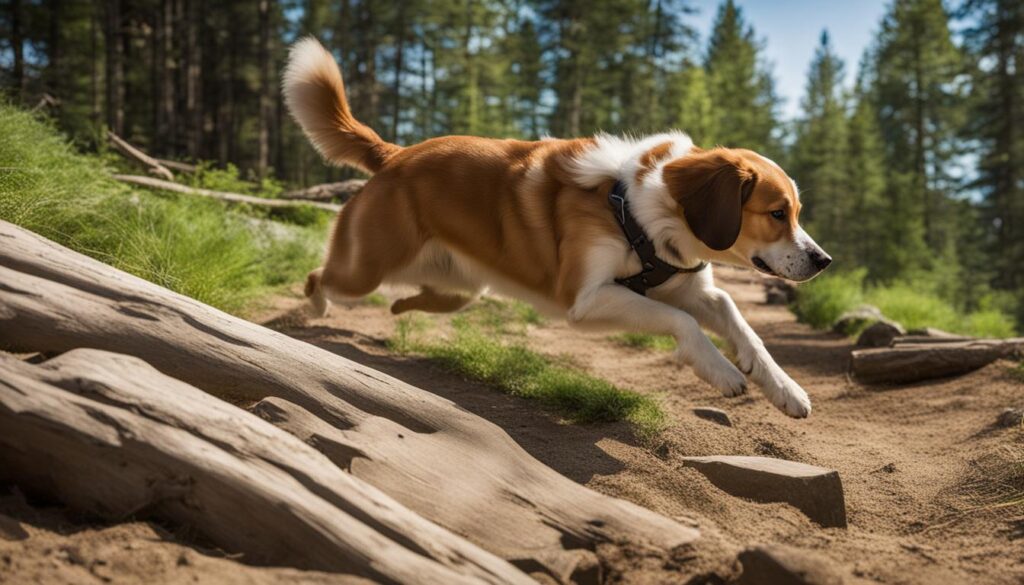
Benefits of Detox Training for Leash Manners
| Benefits | Explanation |
|---|---|
| Improved Focus | Detox training helps your dog develop better focus and attention, allowing them to ignore distractions and stay calm on the leash. |
| Reduced Stress | By teaching your dog to remain calm and composed, detox training can reduce stress and anxiety during walks, creating a more enjoyable experience for both of you. |
| Safe Walks | With detox training, you’ll have better control over your dog’s leash manners, ensuring their safety and the safety of others around them. |
| Improved Bond | Through consistent training and positive reinforcement, detox training can strengthen the bond between you and your dog, fostering a deeper sense of trust and understanding. |
Detox training is a valuable tool for preventing overexcitement and promoting calm leash behavior in your dog. By setting clear boundaries, reinforcing good behavior, and remaining consistent, you can help your dog learn to navigate the world while remaining calm and composed on the leash.
Conclusion
To effectively manage dog hyperactivity, it’s important to utilize a combination of techniques and strategies. By addressing attention deficits, providing early training, incorporating detox training, ensuring regular exercise, understanding your dog’s body language, and utilizing positive reinforcement, you can effectively manage hyperactivity and promote calmness and obedience in your dog.
Start by evaluating whether your dog is getting enough attention and stimulation. Remember, a tired dog is often a calm dog. Engage in activities that challenge their mind, provide interactive toys, and dedicate ample playtime. Additionally, early training plays a pivotal role in setting boundaries and establishing a sense of order and control. Positive reinforcement, firm commands, and consistent training methods help your dog understand what’s expected of them.
Detox training is a powerful technique to prevent overexcitement on leash. Teach your dog that leash time is for calmness, not excitement. Set boundaries and communicate clearly that playful behavior is not allowed. Consistency is key in implementing this training method. And don’t forget, seeking professional help can provide you with the necessary tools and skills to effectively manage your hyperactive dog.
With patience, dedication, and the right approach, you can help your dog find balance, lead a happier life, and enjoy a harmonious relationship with your furry friend.
FAQ
What causes hyperactivity in dogs?
Hyperactivity in dogs can be caused by various factors, such as anxiety and lack of exercise.
How can I effectively manage hyperactivity in my dog?
To effectively manage hyperactivity, it is important to address the root causes and implement strategies that promote calm behavior.
Can attention deficits contribute to hyperactivity in dogs?
Yes, attention deficits and lack of early training can contribute to hyperactivity in dogs.
How can detox training help reduce overexcitement in dogs?
Detox training focuses on teaching your dog to remain calm and composed while on a leash, helping reduce overexcitement.
Why is early training important in managing hyperactivity?
Early training plays a crucial role in managing hyperactivity in dogs by establishing a sense of order and control.
How can I provide enough attention and stimulation to my dog?
Evaluate how much time you spend with your dog and provide ample playtime, interactive toys, and engaging activities that challenge their mind.
What techniques can I use to promote calm behavior in my dog?
Understanding your dog’s body language and using positive reinforcement for good behavior are important techniques to manage hyperactivity.
Can my own mental state influence my dog’s behavior?
Yes, your own mental state can influence your dog’s behavior, so it is important to stay calm and composed.
Should I seek professional help to manage my dog’s hyperactivity?
Seeking professional help from a dog trainer can provide you with the necessary tools and skills to manage canine hyperactivity.
How can I implement detox training for my dog?
Detox training involves setting boundaries and not allowing your dog to engage in playful behavior while on the leash, promoting calmness instead of excitement.


